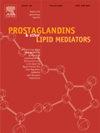用LC-QTOF-MS分析高胆固醇血症Wistar-Kyoto大鼠体内裂叶属植物生物活性成分的代谢谱
IF 2.5
3区 生物学
Q3 BIOCHEMISTRY & MOLECULAR BIOLOGY
Prostaglandins & other lipid mediators
Pub Date : 2025-07-01
DOI:10.1016/j.prostaglandins.2025.107011
引用次数: 0
摘要
动脉粥样硬化是一种炎症,可导致心肌梗死、心脏骤停和中风。在动脉粥样硬化的背景下,蘑菇代谢组学目前的知识仍然不足。因此,有必要进一步研究潜在的途径和代谢物的特征,以建立动脉粥样硬化早期诊断的重要网络。因此,在高胆固醇诱导的大鼠中给予裂叶菜(SPPSC)标准植物修复。评估血清的血脂参数;通过液相色谱联用四极杆飞行时间质谱(LC-QTOF-MS)测定肝脏标志物酶和代谢谱表征。SPPSC抑制了胆固醇、LDL、甘油三酯和动脉粥样硬化系数水平的升高,增加了HDL浓度,恢复了肝脏抗氧化酶的功能。预测精度和偏最小二乘判别分析(PLS-DA)显示正常组、未处理组、橄榄油组和SPPSC处理组的代谢特征有明显的差异。途径分析表明,对抗动脉粥样硬化和心脏保护活性最显著的代谢产物是色氨酸代谢、鞘脂代谢、β-丙氨酸代谢、牛磺酸和次牛磺酸代谢、谷胱甘肽代谢、苯丙氨酸代谢、原胆酸生物合成、组氨酸代谢、泛酸和辅酶a生物合成、半胱氨酸和蛋氨酸代谢。经鉴定的代谢产物表明,黄芪在预防动脉粥样硬化、增强内源性抗氧化系统、保护心血管系统、减轻炎症和调节内皮功能障碍等方面具有新颖的作用。本文章由计算机程序翻译,如有差异,请以英文原文为准。
Metabolic profiling of bioactive components from Schizophyllum commune Fries in hypercholesterolemic Wistar-Kyoto rats using LC-QTOF-MS analysis
Atherosclerosis is an inflammatory condition that contributes to myocardial infarction, cardiac arrest and stroke. Current knowledge of mushroom metabolomics in the context of atherosclerosis remains inadequate. Hence, further investigation into the underlying pathways and characterization of metabolites is necessary to establish a significant network for early-stage diagnosis of atherosclerosis. Therefore, the standard phytopreparation of Schizophyllum commune (SPPSC) was administered in hypercholesterolemic-induced rats. Sera were evaluated for lipid profile parameters; hepatic marker enzymes and the metabolic profile characterization was determined via liquid chromatography coupled with quadrupole time-of-flight mass spectrometry (LC-QTOF-MS). SPPSC suppressed the elevation of cholesterol, LDL, triglyceride and atherogenic coefficient levels while increased HDL concentration and restored the function of hepatic antioxidant enzymes. The predictive accuracies and partial least square discriminant analysis (PLS-DA) revealed clear separation in metabolic features between normal, untreated, olive oil and SPPSC treated groups. Pathway analysis of the most significant metabolites targeted towards anti-atherosclerotic and cardio-protective activities were tryptophan metabolism, sphingolipid metabolism, β-alanine metabolism, taurine and hypotaurine metabolism, glutathione metabolism, phenylalanine metabolism, primary bile acid biosynthesis, histidine metabolism, pantothenate and CoA biosynthesis and cysteine and methionine metabolism. Identified metabolites indicate that S. commune is novel in preventing atherosclerosis and enhancing endogenous antioxidant system, protecting the cardiovascular system, minimalizing inflammation and regulating endothelial dysfunction.
求助全文
通过发布文献求助,成功后即可免费获取论文全文。
去求助
来源期刊

Prostaglandins & other lipid mediators
生物-生化与分子生物学
CiteScore
5.80
自引率
3.40%
发文量
49
审稿时长
2 months
期刊介绍:
Prostaglandins & Other Lipid Mediators is the original and foremost journal dealing with prostaglandins and related lipid mediator substances. It includes basic and clinical studies related to the pharmacology, physiology, pathology and biochemistry of lipid mediators.
Prostaglandins & Other Lipid Mediators invites reports of original research, mini-reviews, reviews, and methods articles in the basic and clinical aspects of all areas of lipid mediator research: cell biology, developmental biology, genetics, molecular biology, chemistry, biochemistry, physiology, pharmacology, endocrinology, biology, the medical sciences, and epidemiology.
Prostaglandins & Other Lipid Mediators also accepts proposals for special issue topics. The Editors will make every effort to advise authors of the decision on the submitted manuscript within 3-4 weeks of receipt.
 求助内容:
求助内容: 应助结果提醒方式:
应助结果提醒方式:


